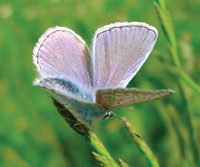|
Where do they go?
High-energy physics labs worldwide are neighbors with numerous butterfly species–from the Common Blue (Polyommatus icarus, photo) found near CERN to the Pipevine Swallowtail (Battus philenor) that shares the Bay Area with SLAC. But where do butterflies go in the winter? While a few species, like Monarchs, migrate to warmer climates, the majority of species spend the winter, wherever they are, in diapause, a metabolic state similar to hibernation.
Butterflies have four stages in their life cycle–egg, larva, pupa, and imago (adult butterfly)–and while you might think they would spend winter as pupae in a cocoon or chrysalis, you’d be only partly correct. “All four stages are out there in the winter,” says Fermilab’s cryogenics engineer Tom Peterson, who is also the resident butterfly expert for the lab 40 miles west of Chicago. “While every species typically has one pattern and overwinters in the same stage every year, right now, in the middle of winter, there are even adult butterflies sitting in the woods, hiding in trees.”
More than 50 butterfly species regularly call Fermilab home, and those that overwinter at the lab as imago include the Eastern Comma (Polygonia comma) and Mourning Cloak (Nymphalis antiopa). Both have cryptic coloring that camouflages them–the only way a butterfly in diapause can avoid predators. Butterflies overwintering as larvae (caterpillars) face dangers as well: they can be extremely sensitive to environmental changes, particularly in humidity and temperature, which makes cold, dry winters difficult for them.
Dawn Stanton
Click here to download the pdf version of this article.







